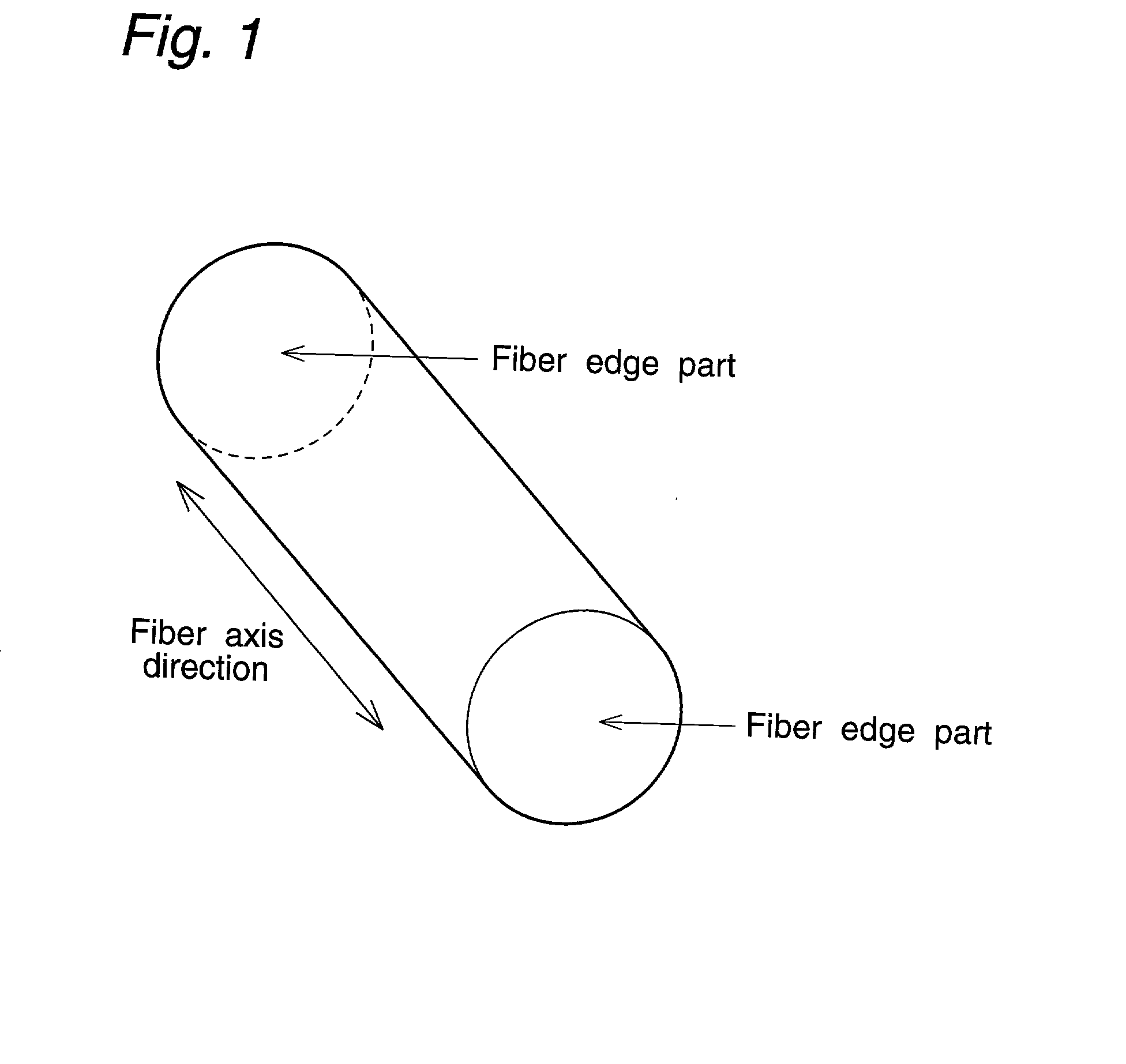Graphite material for negative electrode of lithium ion secondary battery and process for producing the same
a lithium ion secondary battery and negative electrode technology, applied in the direction of electrochemical generators, cell components, electrochemical generators, etc., can solve the problems of short cycle life, poor safety, and insufficient realization of prototype batteries, and achieve excellent charge/discharge cyclability, large discharge capacity, and high charge/discharge efficiency
- Summary
- Abstract
- Description
- Claims
- Application Information
AI Technical Summary
Benefits of technology
Problems solved by technology
Method used
Image
Examples
example 1
[0094] (Production of Graphite Material)
[0095] An optically anisotropic petroleum mesophase pitch having a specific gravity of 1.25 was used as a starting material. Using a spinning nozzle having 500 spinning holes with a 0.2 mm diameter provided in a line in a 3 mm wide slit, the molten pitch was blown by injecting hot air from the slit, thereby pitch fiber having an average diameter of 15 .mu.m was obtained. During the process, the spinning temperature was 360.degree. C. and the output rate was 0.8 g / hole.multidot.min. The spun fiber was collected on a belt having a collection zone of 20-mesh stainless steel net with suction from the backside of the belt.
[0096] The collected fiber mat was heated in air from room temperature to 300.degree. C. at an average heating rate of 6.degree. C. / min to carry out infusibilization. Subsequently, the infusibilized fiber was lightly carbonized at 650.degree. C., and then pulverized by a cross-flow mill, to obtain milled carbon fiber having an ave...
example 2
[0109] The modifying treatment of the graphitized milled carbon fiber prepared in Example 1 was carried out using UltraPlex under treating conditions of a rotor rotation of 3,800 rpm and a throughput rate of 100 kg / H.
[0110] The average particle size of the fiber after the modification treatment was 15.0 .mu.m. As a result of measuring the boron nitride amount generated on the fiber surface by the X-ray photoelectron spectroscopy, the value of (B+N) / (B+N+C+O) was 19.3%(atomic concentration). The fiber had a heat of adsorption of 1-butanol of 111 J / g and a specific surface area of 2.4 m.sup.2 / g, as measured with the above procedures.
[0111] The results of the surface-modifying treatment are given in Table 1.
[0112] (Charge / Discharge Test)
[0113] The procedure of the charge / discharge test of Example 1 was repeated. The first cycle showed a discharge capacity of 348 mA h / g and a charge / discharge efficiency of 92.8%. The 10.sup.th cycle showed a high discharge capacity of 348 mA h / g and a h...
example 3
[0115] (Production of Graphite Material)
[0116] To the milled carbon fiber prepared in Example 1, 3% by weight of boron carbide having an average particle size of 80 .mu.m was added, uniformly mixed with stirring, and thereafter graphitized in an Acheson type furnace (in atmosphere) in the same conditions as in Example 1, to thereby prepare graphitized milled carbon fiber.
[0117] According to measurement by X-ray diffractometry, the resulting graphitized milled carbon fiber had a graphite layer-to-layer spacing (d002) of 0.3358 nm, a size of a crystallite of c-axis direction (Lc) of not less than 100 nm, a size of a crystallite of a-axis direction (La) of not less than 100 nm, and an intension ratio of the diffraction peak of a (101) plane to that of a (100) plane (I.sub.101 / I.sub.100) of 1.90.
[0118] The average particle size of the fiber after the graphitization was 18.5 .mu.m.
[0119] The boron nitride amount generated on the graphitized milled carbon fiber surface was determined from...
PUM
| Property | Measurement | Unit |
|---|---|---|
| temperature | aaaaa | aaaaa |
| particle size | aaaaa | aaaaa |
| length | aaaaa | aaaaa |
Abstract
Description
Claims
Application Information
 Login to View More
Login to View More - R&D
- Intellectual Property
- Life Sciences
- Materials
- Tech Scout
- Unparalleled Data Quality
- Higher Quality Content
- 60% Fewer Hallucinations
Browse by: Latest US Patents, China's latest patents, Technical Efficacy Thesaurus, Application Domain, Technology Topic, Popular Technical Reports.
© 2025 PatSnap. All rights reserved.Legal|Privacy policy|Modern Slavery Act Transparency Statement|Sitemap|About US| Contact US: help@patsnap.com



